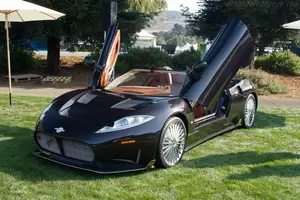


| Vehicle | Curb weight | Difference from world's smallest | Weight to power ratio | 0—60 mph acceleration ratio | Consumption ratio |
|---|---|---|---|---|---|
| 5.0 V8 32V |
1390 kg / 3065 lbs |
965 kg (2128 lbs) heavier | 2 kg to 1 hp | 409 kg/s (902 lbs/s) | - |
| Vehicle | 5.0 V8 32V |
|---|---|
| Curb weight |
1390 kg / 3065 lbs |
| Difference from world's smallest | 965 kg (965 lbs) heavier |
| Weight to power ratio | 2 kg to 1 hp |
| 0—60 mph acceleration ratio | 409 kg/s (902 lbs/s) |
| Consumption ratio | - |

| Vehicle | Curb weight | Difference from world's smallest | Weight to power ratio | 0—60 mph acceleration ratio | Consumption ratio |
|---|---|---|---|---|---|
| 4.2 V8 40V |
1390 kg / 3065 lbs |
965 kg (2128 lbs) heavier | 3 kg to 1 hp | 397 kg/s (875 lbs/s) | - |
| Vehicle | 4.2 V8 40V |
|---|---|
| Curb weight |
1390 kg / 3065 lbs |
| Difference from world's smallest | 965 kg (965 lbs) heavier |
| Weight to power ratio | 3 kg to 1 hp |
| 0—60 mph acceleration ratio | 397 kg/s (875 lbs/s) |
| Consumption ratio | - |

| Vehicle | Curb weight | Difference from world's smallest | Weight to power ratio | 0—60 mph acceleration ratio | Consumption ratio |
|---|---|---|---|---|---|
| 4.2 V8 |
1560 kg / 3440 lbs |
1135 kg (2503 lbs) heavier | 4 kg to 1 hp | 363 kg/s (800 lbs/s) | - |
| Vehicle | 4.2 V8 |
|---|---|
| Curb weight |
1560 kg / 3440 lbs |
| Difference from world's smallest | 1135 kg (1135 lbs) heavier |
| Weight to power ratio | 4 kg to 1 hp |
| 0—60 mph acceleration ratio | 363 kg/s (800 lbs/s) |
| Consumption ratio | - |

| Vehicle | Curb weight | Difference from world's smallest | Weight to power ratio | 0—60 mph acceleration ratio | Consumption ratio |
|---|---|---|---|---|---|
| 4.2i V8 40V |
1275 kg / 2811 lbs |
850 kg (1874 lbs) heavier | 3 kg to 1 hp | 297 kg/s (655 lbs/s) | - |
| Vehicle | 4.2i V8 40V |
|---|---|
| Curb weight |
1275 kg / 2811 lbs |
| Difference from world's smallest | 850 kg (850 lbs) heavier |
| Weight to power ratio | 3 kg to 1 hp |
| 0—60 mph acceleration ratio | 297 kg/s (655 lbs/s) |
| Consumption ratio | - |

| Vehicle | Curb weight | Difference from world's smallest | Weight to power ratio | 0—60 mph acceleration ratio | Consumption ratio |
|---|---|---|---|---|---|
| 4.2 V8 40V |
1000 kg / 2205 lbs |
575 kg (1268 lbs) heavier | 3 kg to 1 hp | 233 kg/s (514 lbs/s) | - |
| Vehicle | 4.2 V8 40V |
|---|---|
| Curb weight |
1000 kg / 2205 lbs |
| Difference from world's smallest | 575 kg (575 lbs) heavier |
| Weight to power ratio | 3 kg to 1 hp |
| 0—60 mph acceleration ratio | 233 kg/s (514 lbs/s) |
| Consumption ratio | - |